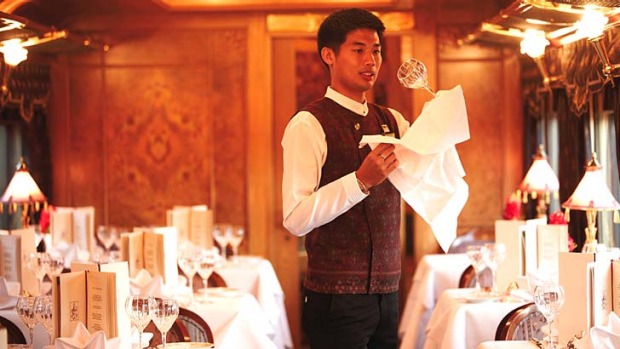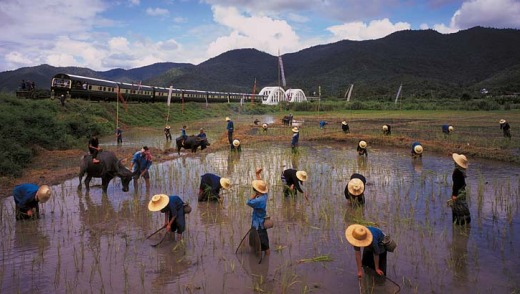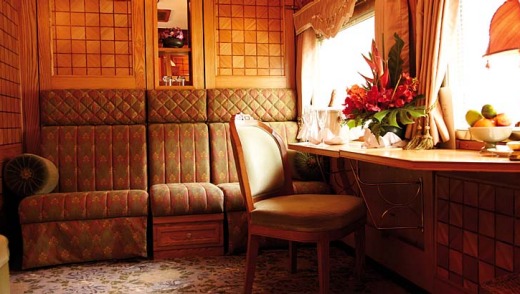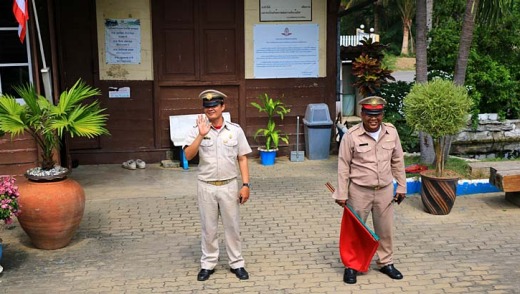
Travelling in opulence by train is a rare treat.
As I sat in the bar, Pimms in hand, the train's motion offered rhythm to the pianist's song. The palm trees outside had been swallowed by the gluggy darkness of an Asian evening, but inside it was all aircon and evening wear, impeccable service, style and unbridled luxury. As I tried vainly to resist the drowsiness induced by the movement - and the consumption of five courses (and afternoon tea) - in the four hours I'd been aboard, I thought, this is something I could get used to.
The Eastern & Oriental Express is a three-day train trip from Singapore to Bangkok. But to describe it as such is to underestimate it. It is a 500-metre-long bubble of colonial romance, luxury and nostalgia. It is time-out from the world of work, worry and Wi-Fi, a chance to sit back and do nothing but watch the world go by, an opportunity to utter rare phrases such as, "Shall we get dressed for dinner and meet for a drink?", playfully instead of pretentiously.

The day began with an early flight to Singapore, a Raffles limousine providing a bridge between my two selves - the writer and kid-wrangler left in Melbourne, and me, the luxury traveller. Raffles is one of the world's iconic hotels and it's easy to see why; it's an oasis of colonial grandeur amid Singapore's modern skyscrapers. It also serves as the check-in for the E&O, providing the perfect place to slip into your on-train fantasy persona.
In the courtyard restaurant, my friend and I channelled 1920s style icons as we sipped Singapore Slings, about 2000 of which are served here daily. And then, with the don't-even-have-to-think-about-it simplicity of five-star travel, we were whisked to Malaysia's cross-border Woodlands Station, with all 22 carriages of gleaming train in front of us, as magical as a south-east Asian Hogwarts Express.
It is a ... bubble of colonial romance, luxury and nostalgia
We stepped aboard into a plush, shiny but somehow understated world of wood panelling, hand-tufted carpets, fringed lamps and brass handles. The carriages were soft underfoot and gleaming with the air of old-world privilege. We settled into our cabins and were soon served afternoon tea by Woody, our cabin steward.

There are three classes of cabin on the train, all en suite. We were in the most basic pullman cabin, six of which make up one carriage. Five larger state cabins take up the same space, while two presidential suites comprise one carriage.
Our cabins were small but well-designed. A sofa runs along one wall, made into a comfortable bed while you're squeezing down five courses. It's a single bed, with another bunk above - not ideal for romance unless you're particularly inventive. A table next to the large windows is perfect for composing witty one-liners to send home while gazing out at the passing view. The bathroom is compact, with a decent shower.
By the time we'd finished scoffing scones, it was time to change for dinner. Jacket and tie or equivalent is customary, but "the train provides the opportunity to display glamour and style". Dress to impress, people. And then for the first challenge - negotiating half a kilometre of moving train wearing heels. A quick G&T in the observation car, an open-sided carriage with adjoining bar at the back of the train, and it was time to walk all the way back to the restaurant cars and our second challenge - five courses of Thai-inspired food.

All the food is prepared in two kitchens smaller (and bumpier) than an oversized car boot, yet taste and presentation is on par with any five-star restaurant. The celery and fennel fronds on the tom yum cappuccino were perfectly curled, while the chef's whites were still gleaming after the delicious green fish curry.
We lounged in the bar car while Peter the pianist played a few numbers, then waddled to the observation car to watch the Kuala Lumpur skyline emerge out of the dense tropical darkness. A stop at the train station allowed us a more graceful return to our cabins.
I was awoken the next morning by breakfast delivered to my bed and the gentle unfolding of a day borrowed from the golden age of travel. There wasn't time for boredom, even though arranged entertainment is minimal - fruit tasting, Thai dancing, an excursion a day. Certainly, there's plenty to do on board - eating and drinking, writing, reading or games in the mobile "reading room", as well as mingling with the other passengers, comprising friends and couples ranging from their 30s to 70s, mothers and daughters, and immaculately coiffed older ladies. And there's the old-fashioned pleasure of watching the world go by, without distractions or demands for food/entertainment/nappy changes.
An excursion to Kanchanaburi, location of the "Bridge over the River Kwai" and Thailand-Burma Railway Centre, was moving, if surreal. It's hard to comprehend the remoteness of the area or the extent of the atrocities that occurred here. The train ride covers 2100 kilometres and a range of landscapes - rural villages, urban sprawl, plantations and agricultural land, dramatic limestone peaks and dense jungle that makes putting your head near the edge of the Observation Car potentially dangerous.
It's always interesting, though, from smiling locals beside the tracks, to rubber trees wearing old-fashioned collection cups ,and the pleasure of lying in bed watching the dawn light reflecting on rice fields.
Then there are the cultural pointers - the gleaming winged temples of Thailand, the colourful spirit houses perched like elaborate dolls' houses in every yard, the changing styles of house and dress. I spent a chunk of my childhood in Bangkok, and it was amazing how familiar it still seemed.
Animal sightings were restricted to mangy dogs and the odd squirrel. I wasn't expecting a wildlife safari, but my childhood memories from trips in the area are of water buffalos in the fields, working elephants and monkeys. Once, during a road trip from our home in Bangkok to KL, we stopped for a jungle tour. We weren't allowed more than arm's length from our mother; she was worried that tigers were lurking in the grass, waiting to devour unaccompanied farang children.
Sadly, she wouldn't have to worry now. There are only about 300 wild tigers left in Thailand, while Malaysia has about 450 of the estimated 3500 wild tigers left in the world. To raise awareness of the tiger's plight (and funds for the non-profit Save Wild Tigers organisation), a one-off "Eastern & Oriental Tiger Express" is running in October, a five-day extravaganza of gala dinners, luxury hotels and train travel.
On my second and final night on the train, I decided on a different approach, combating the food overload with whisky, music and chat. I remember it like Casablanca - witty, meaningful and fleeting - but it was probably more like classy karaoke. The wartime classics were replaced by Elvis numbers as immaculately attired people of all ages and nationalities bonded while speeding through rural Thailand. I stumbled to bed knowing that I didn't have to get anyone's breakfast in the morning, not even my own.
The writer travelled courtesy of Eastern & Oriental Express and Thai Airways.
TRIP NOTES
GETTING THERE
Thai Airways has a return fare to Singapore for about $1238 low season from Melbourne and Sydney including tax. Fly to Bangkok (9hr) then to Singapore (2hr 15min) and back from Bangkok. Phone 1300 651 960 or see thaiairways.com.
TOURING THERE
The Eastern & Oriental Express is a two-night trip from Singapore to Bangkok or three nights in the other direction. From $2860 a person for everything except drinks. The five-day E&O Tiger Express event begins on October 2. For details, see website.
MORE INFORMATION
Belmond.com.